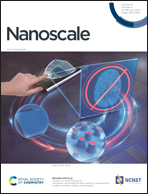Electrostatic assembly of a multicomponent peptide/amphiphile nanotube†
Abstract
The ability to integrate the elements of a multicomponent nanostructure with nanoscale precision by co-assembly provides a versatile strategy to create novel materials with tunable properties. The search for function in these materials will require new strategies to be developed that control the assembly process, especially for structurally dissimilar components, which often have a propensity to self-sort into non-integrated nanostructures. In this work, two components, a peptide (1) and an amphiphile (2), were integratively co-assembled into a multicomponent nanotube. The interaction between the two components at the supramolecular level was driven by the electrostatic complementarity of the components, which was controlled by the pH-dependent charge of 1. Characterization of the co-assembled nanotube, 1–2NT, was achieved using a combination of TEM, AFM, CLSM and SIM techniques, which showed that both components were colocalized within the nanotube. These studies, in conjunction with CD, IR and fluorescence studies, suggested that 1 and 2 were arranged in partially reorganized, self-sorted domains, which were integrated as laminated nanoribbons that coiled together into the final co-assembled nanotube.



 Please wait while we load your content...
Please wait while we load your content...